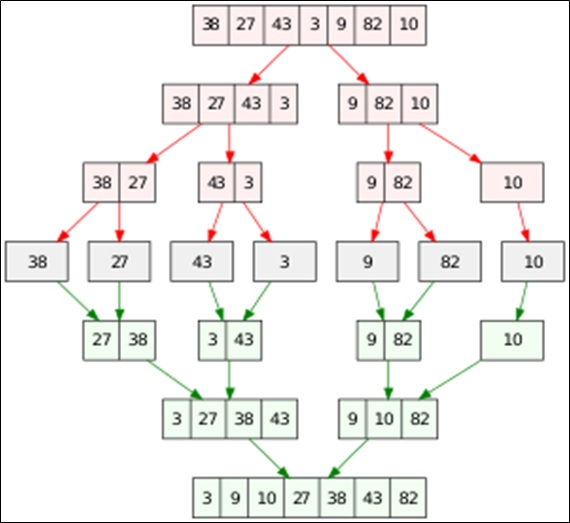合并排序算法排序过程
Merge sort is an algorithm based on the divide and conquer paradigm which was invented by John von Neumann in the year 1945. It is a stable but not an in-place sorting algorithm.
合并排序是一种基于分而治之范式的算法,该算法由约翰·冯·诺伊曼(John von Neumann)于1945年发明。它是一种稳定的算法,但不是就地排序算法。
A stable sorting algorithm is the one where two keys having equal values appear in the same order in the sorted output array as it is present in the input unsorted array.
一种稳定的排序算法是一种具有相等值的键在排序后的输出数组中以与输入未排序数组中存在的键相同的顺序出现的算法 。
An in-place sorting algorithm has various definitions but a more used one is – An in-place sorting algorithm does not need extra space and uses the constant memory for manipulation of the input in-place. Although, it may require some extra constant space allowed for variables.
就地排序算法具有各种定义,但使用更广泛的定义是:–就地排序算法不需要额外的空间,并且使用常量内存来对就地输入进行操作。 虽然,它可能需要一些允许变量使用的额外常量空间。
Merge sort calls two functions. One is the MergeSort() wherein it recursively calls itself for dividing the array into two sub halves till each sub-array has only one element in it and hence, sorted. Then secondly, it calls the merge() function where it merges the two sorted sub halves or sub-arrays into one till only one entire list is obtained.
合并排序调用两个函数。 一个是MergeSort(),其中它递归调用自身以将数组分为两半,直到每个子数组中只有一个元素,然后进行排序。 然后,第二个方法调用merge()函数,在该函数中,将两个排序的子半个或子数组合并为一个,直到仅获得一个完整的列表。
Pseudo-code:
伪代码:
Merge_Sort(arr[], l, r)
If r > l:
1. Find the middle element in the list to divide it into two sub-arrays:
mid = (l + r)/2
2. Call Merge_Sort for first sub-array:
Call Merge_Sort (arr, l, mid)
3. Call Merge_Sort for second sub_array:
Call Merge_Sort(arr, mid+1, r)
4. Merge the two sub_arrays sorted in steps 2 and 3:
Call Merge(arr, l, mid, r)
Example:
例:
Input array: 2 6 1 9
1. Split the list into N sub lists:
(2) (6) (1) (9).
Hence, each list is sorted as there is only one element.
2. Merge the list in pairs starting from index 0.
Merge (2) (6): (2 6)
Merge (1) (6): (1 6)
Merge (2 4) (1 6)
3. Merge two lists (2 4) (1 6):
Compare each element of 1st list with all the elements
of list 2 and insert the smaller one in a new list.
Compare 2 and 1: 1 < 2, insert 1 in the new list first
Compare 2 and 6: 2 < 6, insert 2 in the new list
Compare 4 and 6: 4 < 6, insert 4 in the new list
Insert 6 as it is the only element left
List: (1 2 4 6)
See this image for better understanding of the concept.
The numbers represent the order in which the functions are called.
(Source: Wikipedia)

Time Complexity: The time complexity of the Merge Sort algorithm is defined by the following recurrence relation T(n) = 2T(n/2) + Ɵ(n) where Ɵ(n) is the time complexity of Merge function and is linear.
时间复杂度: 合并排序算法的时间复杂度由以下递归关系T(n)= 2T(n / 2)+Ɵ(n)定义,其中Ɵ(n)是合并函数的时间复杂度,并且是线性的。
The above recurrence relation is solved using the Master's Theorem to obtain the time complexity. The complexity is the same in all the cases because unlike Quick Sort, Merge Sort always divides the array into two equal subparts.
使用Master定理解决上述递归关系以获得时间复杂度。 在所有情况下,复杂度都是相同的,因为与快速排序不同,合并排序始终将数组分为两个相等的子部分。
Worst case: O(N log N)
最坏的情况:O(N log N)
Average Case: Ɵ(N log N)
平均情况:Ɵ(N log N)
Best case: Ω(N log N)
最佳情况:Ω(N log N)
Space Complexity: Ɵ(N)
空间复杂度:Ɵ(N)
Merge Sort Implementation:
合并排序实现:
#include <stdio.h>
void merge(int arr[], int l, int mid, int r)
{
int i, j, k;
int m = mid - l + 1; // Number of elements in first sub array
int n = r - mid; // Number of elements in second half
// create temporary arrays and copy the actual data to these for comparison
int A[20], B[20];
for (i = 0; i < m; i++)
A[i] = arr[l + i];
for (j = 0; j < n; j++)
B[j] = arr[mid + 1 + j];
// Now, merge these temporary arrays after comparison
i = 0;
j = 0;
k = l;
while (i < m && j < n) {
if (A[i] <= B[j]) {
arr[k] = A[i];
i++;
}
else {
arr[k] = B[j];
j++;
}
k++;
}
// This step is done if any of the list has left out elements
while (i < m) {
arr[k] = A[i];
i++;
k++;
}
while (j < m) {
arr[k] = B[j];
j++;
k++;
}
}
void merge_sort(int arr[], int l, int r)
{
if (l < r) {
// This method helps to avoid
// overflow for large l and r
int mid = l + (r - l) / 2;
merge_sort(arr, l, mid); // Call for first half
merge_sort(arr, mid + 1, r); // Call for second half
merge(arr, l, mid, r); // Calling merge function
}
}
int main()
{
int arr[] = { 3, 8, 12, 9, 5, 26 };
int n = sizeof(arr) / sizeof(arr[0]);
printf("Array:\n");
for (int i = 0; i < n; i++)
printf("%d ", arr[i]);
merge_sort(arr, 0, n - 1);
printf("\nAfter performing the merge sort:\n");
for (int i = 0; i < n; i++)
printf("%d ", arr[i]);
return 0;
}
Output:
输出:
Array:
3 8 12 9 5 26
After performing the merge sort:
1 3 5 8 12 26
翻译自: https://www.includehelp.com/c-programs/implement-merge-sort-algorithm.aspx
合并排序算法排序过程







 合并排序是一种由约翰·冯·诺伊曼发明的稳定但非就地排序算法。它采用分而治之的方法,通过递归将数组拆分为单元素子数组,然后使用merge函数将排序的子数组合并回一个有序列表。该算法的时间复杂度在所有情况下均为O(N log N),空间复杂度为O(N)。
合并排序是一种由约翰·冯·诺伊曼发明的稳定但非就地排序算法。它采用分而治之的方法,通过递归将数组拆分为单元素子数组,然后使用merge函数将排序的子数组合并回一个有序列表。该算法的时间复杂度在所有情况下均为O(N log N),空间复杂度为O(N)。














 6569
6569

 被折叠的 条评论
为什么被折叠?
被折叠的 条评论
为什么被折叠?








